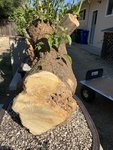1. - You do not "need" any of the expensive "bonsai carving bits", but you may find that the over the counter bits might not last as long as some of the "bonsai carving bits". I would go cheap first. If you don't like the results, you can upgrade later. You might use a saws-all, reciprocating saw to take out some of the bulk, or if you happen to have a die grinder, use that to remove some of the bulk. In the end, many prefer to use hand tools, either a gouge, or a chisel, or even just a pliers to pull individual cellulose threads of wood off for the final finish. Rough in your carving first, then use hand tools or new bits to do the last final carving touches.
2. There are 3 different approaches for handling wood. There are wood sealers, which restore natural oils to wood to keep it water proof, there are wood hardeners which really are only needed for punky, soft, rotting wood, and there are wood preservatives, which include biocides that prevent bacteria and fungi from decomposing the wood. Personally I have had trouble with wood hardeners becoming cloudy, and changing the appearance of the wood. After time they look like plastic laminate was melted to your wood. Chosen well, wood hardener is good for rotting wood, but in general for bonsai, if wood has gone this far we just scrape it out.
Lime sulfur is the go too wood preservative. The lime-sulfur bleaches the wood towards a white color, and it kills bacteria and fungi. It is caustic, which is part of its "biocide" activity. Not everyone likes the color that lime sulfur creates, a bit too stark a white color. You can dilute the lime sulfur to 50% to get a less dramatic color change. Dilution beyond 50% leaves you a product that really doesn't work, too dilute, and the lime sulfur looses its ability to kill fungi & bacteria, and looses it ability to bleach the wood. Some will add water based mineral tints to their lime-sulfur. One would be carbon black, or lamp black, to get a darker color. You could also add burnt umber, or red ochre, to get more a yellow brown or a red-brown tint to the lime sulfur. Lime sulfur is a good preservative for general bonsai use, there is a lot of information about using it in the bonsai literature.
Wood sealers. These are ideal especially for wood recently turned into deadwood. And for wood that is exposed and is not in contact with the soil. Wood sealers are generally based on the idea of restoring the natural resin content to the wood. The "original" wood sealer is boiled linseed oil (often labelled as just linseed oil) available from any paint store that handles oil based paint for painting houses. Thompsons Water Seal is based on linseed oil, with a bunch of additives. I would just use linseed oil for above the soil work. You could also use pine resin, dissolve pine resin, from pitch pine, pinion pine or any other pine species, dissolve the resin in mineral spirits. For either linseed oil or pine resin, paint your deadwood with the solution. It will soak in and leave a dry look fairly rapidly. Apply a second coat, let dry. When it takes about 24 hours to look dry you have penetrated the wood about as much as possible with external painting it on techniques. Your done for a year or two.
Lime sulfur and Linseed oil or pine resin should be reapplied every 2 to 5 years, whenever the wood seems to be dry. By keep the wood protected with natural resins or oils as in linseed oil, the wood is rendered water proof, and without internal water, rot will not take hold.
3. How much should you carve? That is up to you. I would go slow. You have enough wood there on the left that you could create deadwood branches that don't currently exist. Hell, if you are good with wood carving, you could carve in faces, creatures, branches, a whole scene if you want. It all depends on what your "mind's eye" can come up with. Are you an experience woodcarver? If yes, the pallet is yours, create away. If you are not experienced, your red line is safe and a conservative option. Take that big chunk of wood down in stages, so that you can change your design as you get closer to your red line.
Does this help?







